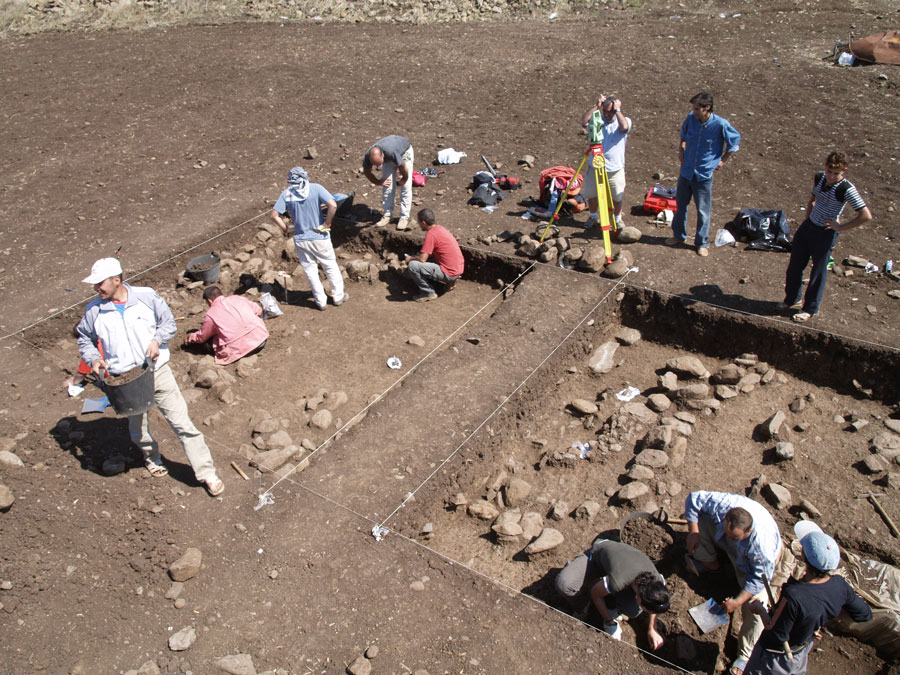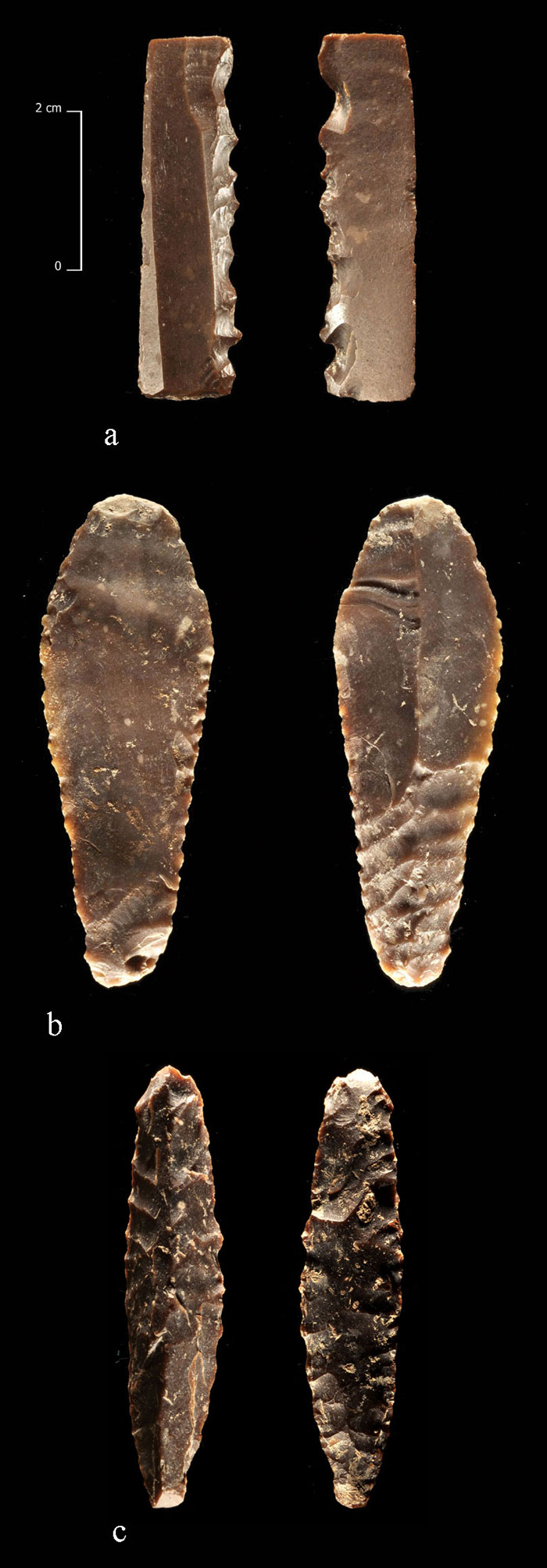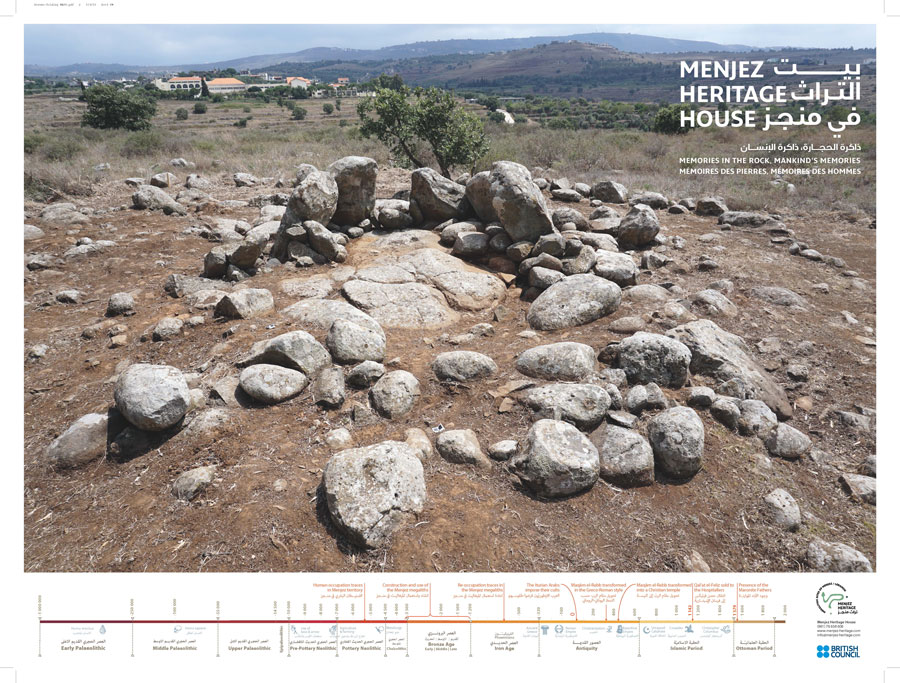Research
The Museum of Lebanese Prehistory is involved as a partner and/or a collaborator in multiple projects (field projects and publications) within Lebanon and Syria. The results of this work has been at the heart of multiple publications, posters, and communications.

Archaeological Survey within the mountains of Anti-Lebanon (2001)
Publications
ARTICLES IN JOURNALS
PIRIE, A., 2001, « A Brief Note on the Chipped Stone Assemblage from PPNA Nachcharini Cave, Lebanon », Neo-Lithics 2001/2, p.8-12.
GARRARD, A., PIRIE A., SCHROEDER, B. and WASSE, A., with contributions by CLARKE, J., HAÏDAR-BOUSTANI, M., RHODES, S. and YAZBECK, C., 2004, « Survey of Nahcharini Cave and prehistoric settlement in the Northern Anti-Lebanon Highlands », BAAL 7 (2003), p. 15-48.
Archaeological Investigations in the Homs region (2004-2010)
Between 2004 and 2010, a Syrian-Lebanese-Spanish mission co-directed by Michel Al Maqdissi (DGAM-Syria), Maya Haïdar-Boustani (Lebanese Prehistory Museum-USJ-Lebanon) and Juan José Ibañez (CSIC-Barcelona) conducted archaeological explorations in the region of Homs. The geographical area of this research is located in western Syria. It extends from the limits of the city of Homs to the east and the Crac des Chevaliers to the west, the village of Chîne to the north and the Lebanese border and the north shore of Lake Qattina to the south. Its total extension is approximately 560 km². This region includes well-differentiated territories: the Orontes Valley, the basaltic plateaus and hills and the Bouqaia plain. The prospecting and study campaigns were followed by soundings and excavations on three sites: Jeftelik (Natufian), Tell Al Marj (Pottery Neolithic) and Tell Ezou (Early Bronze). In addition, a large number of megalithic sites have been surveyed. The data collected show that the territories investigated have been occupied since the Lower Palaeolithic. The large number of archaeological sites found, all periods combined, reflects the archaeological richness of this Syrian region. However, the major contributions of our work are the discovery of the Natufian and the megaliths.
Publications
SELECTED ARTICLES IN JOURNALS
HAÏDAR-BOUSTANI, M., IBÁÑEZ, J.J., AL-MAQDISSI, M., ARMENDÁRIZ, A., GONZÁLEZ URQUIJO, J., TEIRA, L., 2005, « Prospections archéologiques à l’Ouest de la ville de Homs : rapport préliminaire, campagne 2004 », Tempora (Annales d’Histoire et d’Archéologie, Université Saint-Joseph, Beyrouth), Vol. 14-15, p. 59-91.
HAÏDAR-BOUSTANI, M., IBÁÑEZ, J.J., AL-MAQDISSI, M., ARMENDÁRIZ, A., GONZÁLEZ URQUIJO, J., TEIRA, L., 2007, « New data on the Epipalaeolithic and Neolithic of the Homs Gap: Three campaigns of archaeological survey (2004-2006) », Neo-Lithics 1/07, p. 3-9.
HAÏDAR-BOUSTANI, M., IBÁÑEZ, J.J., AL-MAQDISSI, M., ARMENDÁRIZ, A., GONZÁLEZ URQUIJO, J., TEIRA, L., 2008, « Prospections archéologiques à l’Ouest de la ville de Homs : rapport préliminaire, campagne 2005 », Tempora (Annales d’Histoire et d’Archéologie, Université Saint-Joseph, Beyrouth), Vol. 16-17, (années 2005-2006), p. 9-38.
HAÏDAR-BOUSTANI, M., IBÁÑEZ, J.J., AL-MAQDISSI, M., ARMENDÁRIZ, A., GONZÁLEZ URQUIJO, J., TEIRA, L., RODRÍGUEZ , A. , TERRADAS, X., BOIX, J., TAPIA, J., SABREEN, E., 2009, « Prospections archéologiques à l’Ouest de la ville de Homs : campagnes 2006-2007 », Tempora (Annales d’Histoire et d’Archéologie, Université Saint-Joseph, Beyrouth), Vol. 18 (2007-2009), p. 7-49.
RODRÍGUEZ RODRÍGUEZ, A., HAÏDAR-BOUSTANI, M., GONZÁLEZ URQUIJO, J.E., IBÁÑEZ, J.J, M., AL-MAQDISSI, M., TERRADAS, X., ZAPATA L., 2010, « Jeftelik: A New Early Natufian Site in The Levant (Homs Gap, Syria) », Antiquity Vol. 84, issue 323, March 2010, on line: http://www.antiquity.ac.uk/projgall/ibanez323/
HIMI, M., ARMENDARIZ, A., TEIRA, L., GONZÁLEZ, J., IBÁÑEZ, J.J., HAÏDAR-BOUSTANI, M., CASAS, A., 2016, Geophysical and Archaeological Evidences of Buried Epipalaeolithic, Neolithic, Bronze Age and Roman Architecture in West-Central Syria.Archaeological Prospection 9999. Published online in Wiley Online Library https://doi.org/10.1002/arp.1543
ARMENDÁRIZ, A., IBÁÑEZ, J.J., HAÏDAR-BOUSTANI, M., GONZÁLEZ, J.E., RODRÍGUEZ A., TEIRA, L., 2018, El Natufiense del levente mediterráneo y el nuevo sitio de Jeftelik (Siria centro-occidental), Anejos de NAILOS, Estudioas Interdisciplinares de Archeología, Asociación de Profesionales Independientes de la Arqueología de Asturias, nº 4, p. 21-39.
SELECTED ARTICLES IN BOOKS
ARMENDÁRIZ, A., TEIRA, L., AL-MAQDISSI, M., HAÏDAR-BOUSTANI, M., IBÁÑEZ, J.J. and GONZÁLEZ URQUIJO, J., 2008a, « The megalithic necropolises in the Homs Gap (Syria). A preliminary approach », in: CÓRDOBA J., MOLIST M., PÉREZ C., RUBIO I. MARTÍNEZ S. (eds.), Proceedings of the 5th International Congress on the Archaeology of the Ancient Near East , Vol. I, p. 151-162, Universidad Autónoma de Madrid Ediciones, Madrid, April 3-8, 2006.
IBÁÑEZ, J.J., HAÏDAR-BOUSTANI, M., AL-MAQDISSI, M., ARMENDÁRIZ, A., GONZÁLEZ URQUIJO, J., TEIRA, L., 2008b, « Archaeological survey in the Homs Gap (Syria). Campaigns of 2004 and 2005 », in: CÓRDOBA J., MOLIST M., PÉREZ C., RUBIO I. MARTÍNEZ S. (eds.), Proceedings of the 5th International Congress on the Archaeology of the Ancient Near East, Vol. II, p. 187-203, Universidad Autónoma de Madrid Ediciones, Madrid, April 3-8, 2006.
IBÁÑEZ, J.J, HAÏDAR-BOUSTANI, M., AL-MAQDISSI, M., ARMENDÁRIZ, A., GONZÁLEZ URQUIJO, J.,TEIRA, L., 2010, « Découverte de nécropoles mégalithiques à l’ouest de Homs », in : AL-MAQDISSI, M., BRAEMER, F. et DENTZER, J.-M. (dirs.), Hauran V. La Syrie du sud du Néolithique à l’antiquité tardive. Recherches récentes, Actes du colloque de Damas 2007, Vol. I, p. 359-366, Bibliothèque archéologique et historique T. 191, IFPO, Beyrouth.
ARMENDÁRIZ, A., IBÁÑEZ, J.J, M., AL-MAQDISSI, M., HAÏDAR-BOUSTANI, M., TEIRA, L. GONZÁLEZ URQUIJO, J., 2011, « The megalithic necropolises at the West of Homs (Syria) », in: STEIMER-HERBET T. (dir.), Pierres levées, stèles anthropomorphes et dolmens/Standing stones, anthropomorphic stelae and dolmens, Colloque International, Amman 15-17 juin 2007, BAR IS XXXX, p. 55-65.
ARMENDARIZ GUTIERREZ, A., TEIRAL, L. TAPIA SAGRANA, J., HAÏDAR-BOUSTANI M., GONZÁLEZ URQUIJO J.E., IBÁÑEZ ESTEVEZ, J.J, 2012, « Las necrópolis megalíticas de la región de Homs (Siria) », in: MUÑIZ ÁLVAREZ, J. R., (Coord.), AD ORIENTEM. Del final del Paleolitico en el norte de España a las primeras civilizacions del Oriente Próximo. Universidad de Oviedo- Ménsula Ediciones, pp.479-499.
IBÁÑEZ, J.J., TERRADAS, X., ARMENDÁRIZ, A., GONZÁLEZ URQUIJO, J., TEIRA, L., BRAEMER, F., GOURICHON, L., HAÏDAR-BOUSTANI, M., RODRÍGUEZ RODRÍGUEZ, A., 2012, « Nouvelles données sur les architectures des sites natoufiens de Jeftelik et Qarassa 3 (Syrie centro-occidentale et du sud) », in : MONTERO FENELLÓS J.-L (éd.), Du village néolithique à la ville syro-mésopotamienne, Vème Rencontre Syro-Franco-Ibérique d’Archéologie et d’Historie Ancienne du Proche-Orient 21-22 novembre 2011, Facultade de Humanidades, Universidade da Coruña, Bibliotheca Euphratica Vol. 1, p. 9-33.
RODRÍGUEZ RODRÍGUEZ, A., HAÏDAR-BOUSTANI, M., GONZÁLEZ URQUIJO, J.E., IBÁÑEZ, J.J., AL-MAQDISSI, M., TERRADAS, X., ZAPATA, L., 2013, «The Early Natufian Site of Jeftelik (Homs Gap, Syria) », in : BAR-YOSEF O. & VALLA F.R. (eds.), Natufian Foragers in the Levant. International Monographs in Prehistory. Archaeological Series 19. Ann Arbor, Michigan, p. 61-72.
POSTERS
GONZÁLEZ URQUIJO, J.E., IBÁÑEZ, J.J., HAÏDAR-BOUSTANI, M., AL-MAQDISSI, M., 2009, Tell Al Marj: a New PN Site in the Homs Gap, Interpreting the Late Neolithic of Upper Mesopotamia, Conference, 26-28 March 2009, The National Museum of Archaeology, Leiden.
RODRÍGUEZ RODRÍGUEZ, A., ARMENDÁRIZ, A., PERALES, U., TERRADAS, X., HAÏDAR-BOUSTANI, M., GONZÁLEZ URQUIJO, J.E., IBÁÑEZ, J.J., ZAPATA, L., TEIRA, L., ARRANZ A., 2012, The Lithic Assemblage of Jeftelik, an Early Natufian Site in the Homs Gap, 7th International Conference on the Chipped and Ground Stone Industries of the Pre-Pottery Neolithic (PPN7), 14-17 February, Centre d’Estudis I Recursos Culturals/Universitat Autònoma de Barcelona.
GONZÁLEZ URQUIJO, J.E., LAZUÉN, T., HAÏDAR-BOUSTANI, M., TEIRA, L., IBÁÑEZ, J. J., 2012, Arrowheads and sickles. Lithic Tools at the Pottery Neolithic Site of Tell Al Marj (Syria), 7th International Conference on the Chipped and Ground Stone Industries of the Pre-Pottery Neolithic (PPN7), 14-17 February, Centre d’Estudis I Recursos Culturals/Universitat Autònoma de Barcelona.
HAÏDAR-BOUSTANI, M., IBÁÑEZ, J.J., AL-MAQDISSI, M., 2015, Archaeological Discoveries in the Homs Gap by a Syrian-Lebanese-Spanish Mission (2004-2010), ISCACH (International Syrian Congress on Archaeology and Cultural Heritage), 3-6 December, Gefinor Rotana Hotel, Beirut.





Archeological Investigations at Tell Labwe South (North Beqa‛ Valley) (2011)
Within the context of a Lebanese-Spanish mission co-directed by Maya Haidar-Boustani (Museum of Lebanese Prehistory) and Juan Jose Ibanez (CSIC-Barcelona), archeological investigations were conducted at Tell Labwe South in 2011. Located in the Beqa’ Valley, 30 kilometers to the north of Baalbek, this well-known site was surveyed by Diana Kirkbride in 1966. The first objective of the 2011 campaign was to complete the data found through the surveys by applying a multidisciplinary approach. The stratigraphy of the largest preserved section of the Tell revealed 4 levels from the end of the Middle PPNB/beginning of the Recent PPNB (level IV) until the Pottery Neolithic (level I), which are rich in architectural remains, material and plant macroremains. According to the dates obtained, the foundation of the village dates back to the end of the 7th millennium BC (8100 ± 40 BP) and the last occupation to the beginning of the 6th millennium BC (7640 ± 40 BP). According to the current state of knowledge, it is the oldest sedentary settlement in Lebanon where the domestication of cereals and slaughter animals is attested. The first villagers of Labwe were not isolated from the rest of the world. The presence of pieces in obsidian, a nonlocal raw material, testifies contacts with Turkey. Physicochemical analysis have shown that this material came from Cappadocia, Taurus and Lake Van.
Publications
ARTICLE IN A JOURNAL
HAÏDAR-BOUSTANI, M. et IBÁÑEZ, J.J. Avec les contributions de Amaia ARRANZ, Bernard GRATUZE, Mahjoub HIMI, Lamya KHALIDI et Luis TEIRA, 2014, « Nouveaux travaux archéologiques à Tell Labwé Sud (Béqa‛ nord). Campagne 2011», BAAL 15 (2011), p. 5-28.
ARTICLE IN A BOOK
KHALIDI, L., GRATUZE, B., HAÏDAR-BOUSTANI, M., IBÁÑEZ, J.J. and TEIRA, L. 2013, « Results of Geochemical Analyses of Obsidian Artefacts from the Neolithic Site of Tell Labwe South, Lebanon », 7th Conference on PPN Chipped and Ground Stone Industries of the Fertile Crescent, Universitat Autònoma de Barcelona, Servei de Publicacions, Spain, p. 475-494.
POSTERS
HAÏDAR-BOUSTANI, M., IBÁÑEZ, J.J., KHALIDI, L., HIMI, M., ARRANZ, A., TEIRA, L., 2012, New Archaeological works in Tell Labwe South (Beqa‛ Valley, Lebanon), 7th International Conference on the Chipped and Ground Stone Industries of the Pre-Pottery Neolithic (PPN7), 14-17 February, Centre d’Estudis I Recursos Culturals/Universitat Autònoma de Barcelona.
GYUROVA, D., ARRANZ-ORTEGUI ,A., RICHTER,T., SAGNELLI, D., HAÏDAR-BOUSTANI, M., IBÁÑEZ, J.J., 2016, The Plant Macroremains from Late PPNB and Early Pottery Neolithic at Tell Labwe South (Lebanon), 17th Conference of the International Work Group for Palaeoethnobotany (IWGP), July 4-9, Museum National d’Histoire Naturelle, Paris.







PaleoLIB - Paleoenvironments and occupation of the ground in Lebanon during the Holocene (2013-2014)
As part of this project, which constitutes an extension to the initial ANR-PaléoSyr project, led by Bernard Geyer (Archéorient) and Franck Braemer (CEPAM) (2011-2014), The Museum of Lebanese Prehistory collaborated during the field campaign aimed at taking samples (cores) from the wet sediments of the Beqa‛ and to supply the database of archaeological sites. Also an exhibition entitled Man and Landscape in Lebanon: 200,000 years of adaptation was produced in 2015 (see Activities and Events).




Survey and soundings in Qleiaat (Kesrouan-Mount Lebanon) (2017)
The archaeological field research conducted in Qleiaat (Kesrouan- Mount Lebanon) by a French-Lebanese mission co-directed by Johnny Samuel Baldi (ifpo, Beirut) and Maya Haïdar- Boustani (Museum of Lebanese Prehistory) revealed a site occupied from the Pottery Neolithic (6500 – 5800 BC) until the Early Bronze Age III (2800 – 2600 BC).
Protection and Valorization of Menjez Megalithic Sites (Akkar) (2018-2019)
Publications
ARTICLES IN JOURNALS
STEIMER-HERBET, T., COUSSEAU, F., PORRA-KUTEN,I V., HAÏDAR-BOUSTANI, M., CAMINADA, A. et BESSE, M., 2018, « Ancêtres et serpents dans les dolmens de Menjez (Akkar, Liban). Étude préliminaire d’une cohabitation singulière, vers 3500 avant notre ère », BAAL 18, p. 389-396.
STEIMER-HERBET, T., COUSSEAU, F., HAÏDAR-BOUSTANI, M., PORRA-KUTENI, V., CAMINADA, A. et BESSE, M.,2019, « Monuments mégalithiques de Menjez (Akkar): études des architectures et gravures. Campagne 2018», BAAL 19, p. 229-258.
STEIMER-HERBET T., COUSSEAU F., HAÏDAR-BOUSTANI M., PORRA-KUTENI V., BESSE M. 2020, « Megalithic art in the Levantine Rift Valley: The case of the Menjez megalithic monuments in the Akkar (Northern Lebanon) », Akkadica 141 (fasc.1), p. 1-24.
BOOKLET
STEIMER-HERBET, T., HAÏDAR-BOUSTANI, M., PORRA-KUTENI, V., with contributions from: COUSSEAU, F., CAMINADA, A., YOUSSEF, G.et BESSE, M., 2019,Memories in the Rock. Mankind’s Memories. Archaeological Heritage of Menjez. Beirut, Impression Salim Dabbous Printing Company s.a.r.l.






